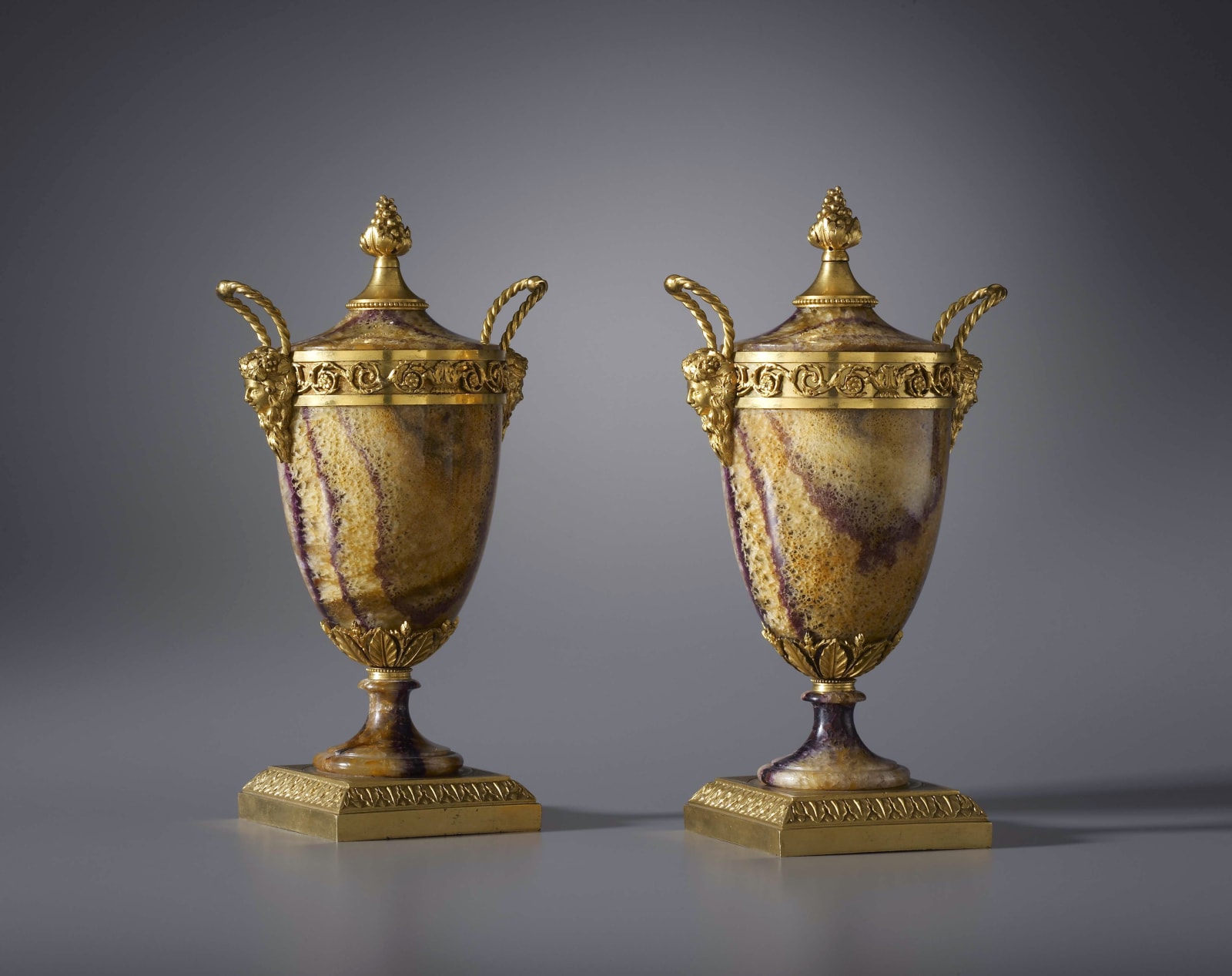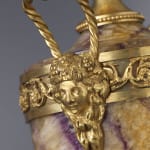Matthew Boulton (attributed to) 1728-1809
A magnificent pair of Georgian gilt bronze mounted blue john covered vases attributed to Matthew Boulton, each surmounted by a berried and foliate finial, the vase-shaped body mounted at the top with a delicate rinceaux frieze with a beautiful pair of female mask headed and spiralled handles, the foot of the vase headed by a palmetted foliate ring on a square stepped and foliate cast base
Soho, Birmingham, date circa 1780
Height 28 cm, width 15 cm. each.
The present vases can be compared to a series of gilt bronze or ormolu mounted blue john covered vases, cassolettes and perfumer burners produced by Matthew Boulton (1728-1809) at his Soho manufactory, Birmingham. Comparisons can be drawn with an ormolu mounted red blue john perfume burner with rams' heads below scrolled handles and laurel swags (illustrated in Nicholas Goodison, "The Work of Matthew Boulton", 1974, p. 310, pl. 291), which itself is based on a sketch from Boulton and Fothergill's Pattern Book I, p. 137. Other comparisons can be drawn with a mounted blue john cassolette, based on a design in the Pattern Book I, pp. 171 and 170 (illustrated ibid. pls. 161 and 163) as well as a pair of ormolu mounted ovoid body blue john covered candle vases, which as here have a berried and foliate finial (illustrated ibid. p. 309, pls. 288-289). In turn the latter are based on a sketch in the Pattern Book I, p. 170.
Excavated exclusively from the hillside at Mam Tor, near Castleton in Derbyshire England after the 1760's, blue john was used by stonemasons in the creation of luxury ornamental works for more affluent collectors. This rare semi-precious mineral with shades that range from violet to deep purple and incorporates oranges and yellows as well as translucent grey opaque veining, is the finest of the rare fluorspar mineral deposits from the Castleton area. During the late eighteenth century it was exported to France for luxury objects, hence it derived its name from the French 'bleu jaune', meaning blue yellow.
The English bronze worker, Matthew Boulton took a particular interest in this material after 1768 and mentioned it in a letter to his friend John Whitehurst. Boulton decided not to proceed with this particular mining project but claimed later to have had exclusively rights to the production. In actual fact in 1770 he bought more than 14 tons of blue john from a merchant named John Platt. At that point Boulton became a specialist in fluorspar and in particular the variety known as blue john.
Boulton worked initially as a 'toymaker' but then enlarged his manufacturing horizons, rebuilding his Soho manufactory during the mid 1760's, which enabled him to diversify his business considerably and to turn his attention to larger and more expensive items such as Sheffield Plate, silver and ormolu. He and his partner John Fothergill began to engage in the luxury trade of gilt bronze products in about 1767, in an attempt to rival those made in France. He is also known to copy or emulate their products so that at times his designs adhere closely to French prototypes. His interest in vases appears to date from the same period, for in that year an agent in Italy purchased on his behalf four volumes of prints of William Hamilton's collection of vases. Boulton was also well aware of the growing fashion in vases, which his friend Josiah Wedgwood and other manufacturers were actively encouraging.
Furthermore during a visit to Paris in 1765, Boulton had seen work by the French bronziers which he considered rivalled 'all the world in elegance and cheapness'. In fact Boulton was incensed that a number of French metal workers travelled to London, purchase any number of vases at a low price and then took them back to Paris, where they mounted them and then had the audacity to sell to "the virtuosi of every nation, and particularly to Millords d'Anglise, for the greatest raritys."



